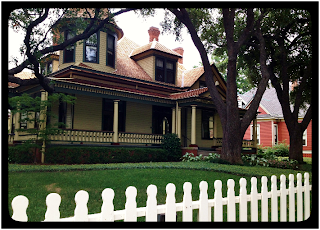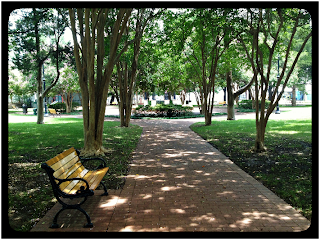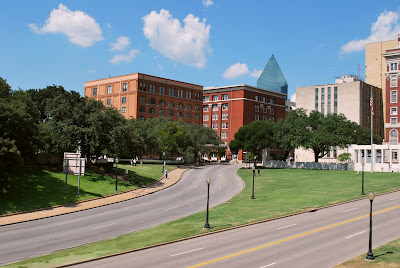Swiss Avenue and the very mysterious Wilson House
 |
| View of the Wilson House from the front yard illustrating the wraparound porch and rising turret. |
Today (July 26, 2013) marks the 23rd anniversary of the Americans with Disabilities Act (ADA), so I thought I would focus on a piece of Dallas that is ADA accessible and totally free. Initially, I was going to try to visit the statue of communist icon Vladimir Lenin mentioned in the book Texas Curiosities (published in 2000). According to the book, the statue was located in front of the Lover’s Lane location of Goff’s hamburgers, facing west, with a small plaque at the bottom that said “America Won”. I quickly learned that Goff’s Hamburgers relocated to its current Hillcrest Road location several years ago, and Roadside America reports that the statue was auctioned off on eBay in 2004. That’ll teach me to use a 13-year-old guidebook.
So instead, I turned to tripadvisor.com for recommendations. That was where I saw a small blurb on the Swiss Avenue Historic District with a phone number for the Dallas Historic Preservation League, now called Preservation Dallas. I called the number and learned that the giant Victorian homes along Swiss Avenue and N. Fitzhugh Avenue and La Vista Drive are all occupied residential homes, but tourists can visit the Wilson House at 2922 Swiss Avenue (incidentally, this is also the office for Preservation Dallas). Swiss Avenue Historic District is still a beautiful area to drive or walk through, but the Wilson Block Historic District offers a lot more for visitors.
According to Preservation Dallas, the Wilson House was built in 1899 after Henrietta Frichot Wilson and husband Frederick Wilson acquired the entire city block from her uncle, Jacob Nussbaumer. They built six more houses on the land that were mainly rented out to family members. This area of Swiss Avenue is now known as the Wilson Block Historic District, and is owned and operated by the Meadows Foundation.
 |
| This house, located on the opposite end of the block from the Wilson House, belonged to the Beilharz family. Mrs. Beilharz and Mrs. Wilson were sisters. |
In the 1970s and 1980s, much of the home’s interior was sold or covered up, so a lot of the home (including the second floor) is simply office space today. But the little that remains is very fascinating simply for the mystery behind it. For example, a mural was uncovered above the front entryway that features scenes set in unknown locations. Little is known about the mural except that it was not original to the house, and believed to have been commissioned by Henrietta sometime around the beginning of the 20th Century. Parts of the mural are still in the process of being restored due to damage that occurred when the mural was covered up.
 |
| These two scenes from the mural depict unknown locales that are clearly not set in Dallas. The style is very Art Nouveau. |
The biggest mystery of the home is the story of Henrietta and Frederick’s daughter, Irma. Irma died in 1918 and her cause of death is unknown. Though there are a couple of stories about the circumstances, including one that suggests she actually died in the turret of the Wilson Home, Preservation Dallas said there is not enough evidence to be sure of what actually occurred.
 |
| This photo depicts the Wilson children (Irma and Laurence) with neighborhood children who were likely family members. |
 |
| Historians believe the stained glass window pictured above was ordered by catalog and shipped here by train. |
Another (albeit less exciting) mystery is the stained glass windows. The stained glass and (more importantly) the giant single panes were marks of wealth, as the technique for creating large panes of glass was a new and costly endeavor at the turn of the last century. It is not known whether the glass was local or imported, though historians believe the stained glass was probably ordered by catalog. This was not uncommon in Dallas during the late 1800s and early 1900s due to the nearby railroads.
The home also features a basement that is currently closed to the public. Basements are still unusual architectural features in Texas. The theory is that the basement was either used as servant’s quarters (though there is a Servant’s Quarters building located behind the home), or as a cold cellar for refrigeration purposes.
The tour of the home takes about 20-30 minutes on the long end, depending on how many questions you have. After your tour, you can take the kids or a picnic lunch to the park located across the street from the Wilson House. A walking tour brochure is also available for those interested in taking a stroll along the block to check out the other Victorian homes. The neighboring homes are not open to the public, but are used as a sort of incubator for nonprofit organizations. Essentially, any nonprofit can apply for rent-free office space in the restored homes (for a set amount of time) on the condition that they are working toward a charitable goal and are willing to work with the Meadows Foundation and other agencies occupying the Wilson District to improve their management.
 The Wilson House
The Wilson House2922 Swiss Avenue, Dallas, TX 75204
(214) 821-3290
Open Tuesday through Friday from 10:00 a.m. until 4:00 p.m.
Admission is free, but donations are gladly accepted.



Comments
Post a Comment